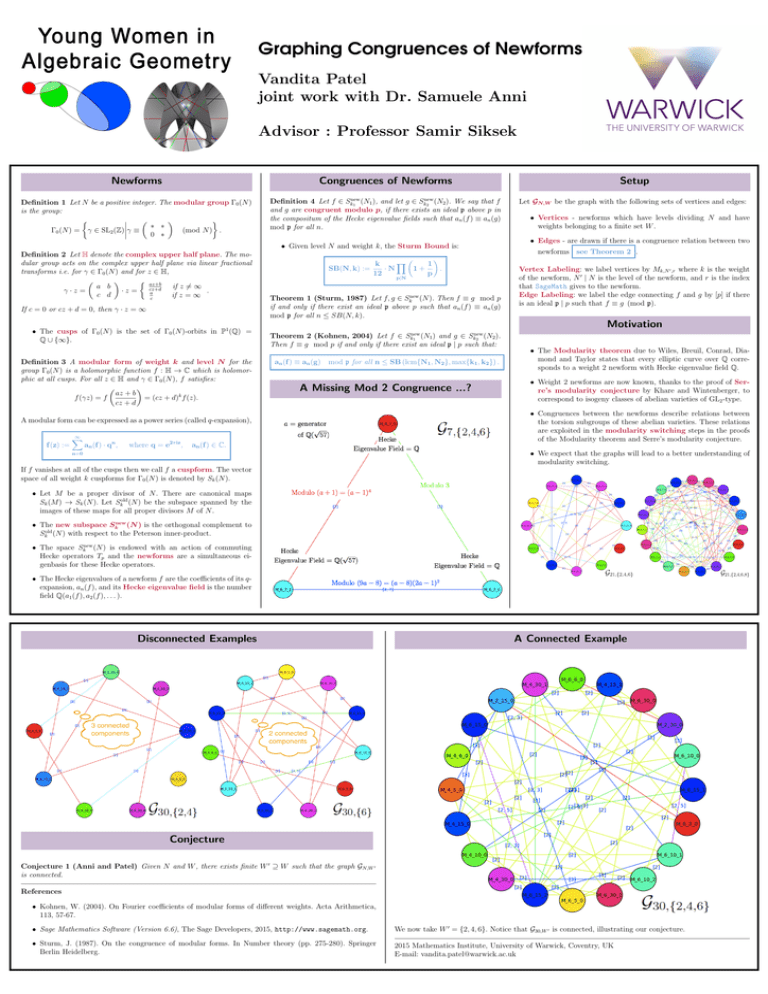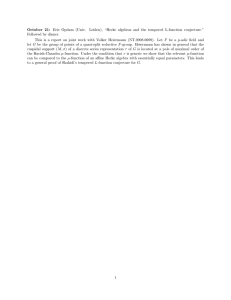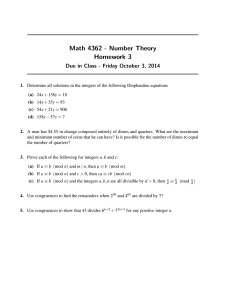Graphing Congruences of Newforms Vandita Patel joint work with Dr. Samuele Anni
advertisement

Graphing Congruences of Newforms
Vandita Patel
joint work with Dr. Samuele Anni
Advisor : Professor Samir Siksek
Newforms
Congruences of Newforms
Setup
Definition 1 Let N be a positive integer. The modular group Γ0 (N )
is the group:
∗ ∗
Γ0 (N ) = γ ∈ SL2 (Z)γ ≡
(mod N ) .
0 ∗
Definition 4 Let f ∈ Sknew
(N1 ), and let g ∈ Sknew
(N2 ). We say that f
1
2
and g are congruent modulo p, if there exists an ideal p above p in
the compositum of the Hecke eigenvalue fields such that an (f ) ≡ an (g)
mod p for all n.
Let GN,W be the graph with the following sets of vertices and edges:
• Given level N and weight k, the Sturm Bound is:
Definition 2 Let H denote the complex upper half plane. The modular group acts on the complex upper half plane via linear fractional
transforms i.e. for γ ∈ Γ0 (N ) and for z ∈ H,
az+b
if z 6= ∞
a b
cz+d
γ·z =
·z =
.
a
c d
if
z=∞
c
If c = 0 or cz + d = 0, then γ · z = ∞
• The cusps of Γ0 (N ) is the set of Γ0 (N )-orbits in P1 (Q) =
Q ∪ {∞}.
Definition 3 A modular form of weight k and level N for the
group Γ0 (N ) is a holomorphic function f : H → C which is holomorphic at all cusps. For all z ∈ H and γ ∈ Γ0 (N ), f satisfies:
az + b
f (γz) = f
= (cz + d)k f (z).
cz + d
SB(N, k) :=
k
·N
12
f (z) :=
an (f ) · qn ,
where q = e2πiz ,
p|N
1+
1
p
• Edges - are drawn if there is a congruence relation between two
newforms see Theorem 2 .
.
Theorem 1 (Sturm, 1987) Let f, g ∈ Sknew (N ). Then f ≡ g mod p
if and only if there exist an ideal p above p such that an (f ) ≡ an (g)
mod p for all n ≤ SB(N, k).
Vertex Labeling: we label vertices by Mk,N 0 ,r where k is the weight
of the newform, N 0 | N is the level of the newform, and r is the index
that SageMath gives to the newform.
Edge Labeling: we label the edge connecting f and g by [p] if there
is an ideal p | p such that f ≡ g (mod p).
Motivation
Theorem 2 (Kohnen, 2004) Let f ∈ Sknew
(N1 ) and g ∈ Sknew
(N2 ).
1
2
Then f ≡ g mod p if and only if there exist an ideal p | p such that:
an (f ) ≡ an (g)
mod p for all n ≤ SB (lcm{N1 , N2 }, max{k1 , k2 }) .
A Missing Mod 2 Congruence ...?
A modular form can be expressed as a power series (called q-expansion),
∞
X
Y
• Vertices - newforms which have levels dividing N and have
weights belonging to a finite set W .
an (f ) ∈ C.
• The Modularity theorem due to Wiles, Breuil, Conrad, Diamond and Taylor states that every elliptic curve over Q corresponds to a weight 2 newform with Hecke eigenvalue field Q.
• Weight 2 newforms are now known, thanks to the proof of Serre’s modularity conjecture by Khare and Wintenberger, to
correspond to isogeny classes of abelian varieties of GL2 -type.
• Congruences between the newforms describe relations between
the torsion subgroups of these abelian varieties. These relations
are exploited in the modularity switching steps in the proofs
of the Modularity theorem and Serre’s modularity conjecture.
• We expect that the graphs will lead to a better understanding of
modularity switching.
n=0
If f vanishes at all of the cusps then we call f a cuspform. The vector
space of all weight k cuspforms for Γ0 (N ) is denoted by Sk (N ).
• Let M be a proper divisor of N . There are canonical maps
Sk (M ) → Sk (N ). Let Skold (N ) be the subspace spanned by the
images of these maps for all proper divisors M of N .
• The new subspace Sknew (N ) is the orthogonal complement to
Skold (N ) with respect to the Peterson inner-product.
• The space Sknew (N ) is endowed with an action of commuting
Hecke operators Tp and the newforms are a simultaneous eigenbasis for these Hecke operators.
• The Hecke eigenvalues of a newform f are the coefficients of its qexpansion, an (f ), and its Hecke eigenvalue field is the number
field Q(a1 (f ), a2 (f ), . . . ).
Disconnected Examples
A Connected Example
Conjecture
Conjecture 1 (Anni and Patel) Given N and W , there exists finite W 0 ⊇ W such that the graph GN,W 0
is connected.
References
• Kohnen, W. (2004). On Fourier coefficients of modular forms of different weights. Acta Arithmetica,
113, 57-67.
• Sage Mathematics Software (Version 6.6), The Sage Developers, 2015, http://www.sagemath.org.
We now take W 0 = {2, 4, 6}. Notice that G30,W 0 is connected, illustrating our conjecture.
• Sturm, J. (1987). On the congruence of modular forms. In Number theory (pp. 275-280). Springer
Berlin Heidelberg.
2015 Mathematics Institute, University of Warwick, Coventry, UK
E-mail: vandita.patel@warwick.ac.uk




